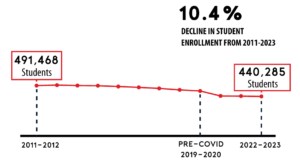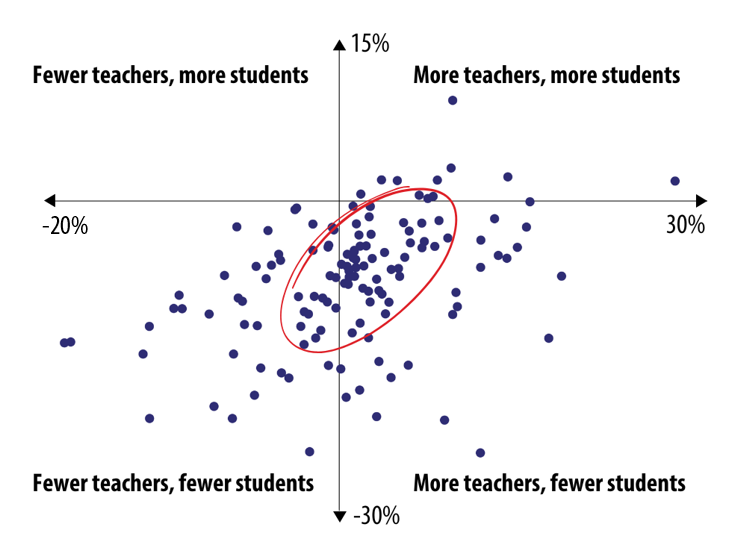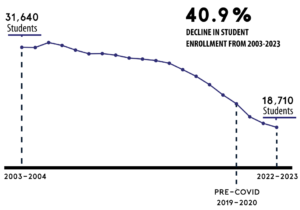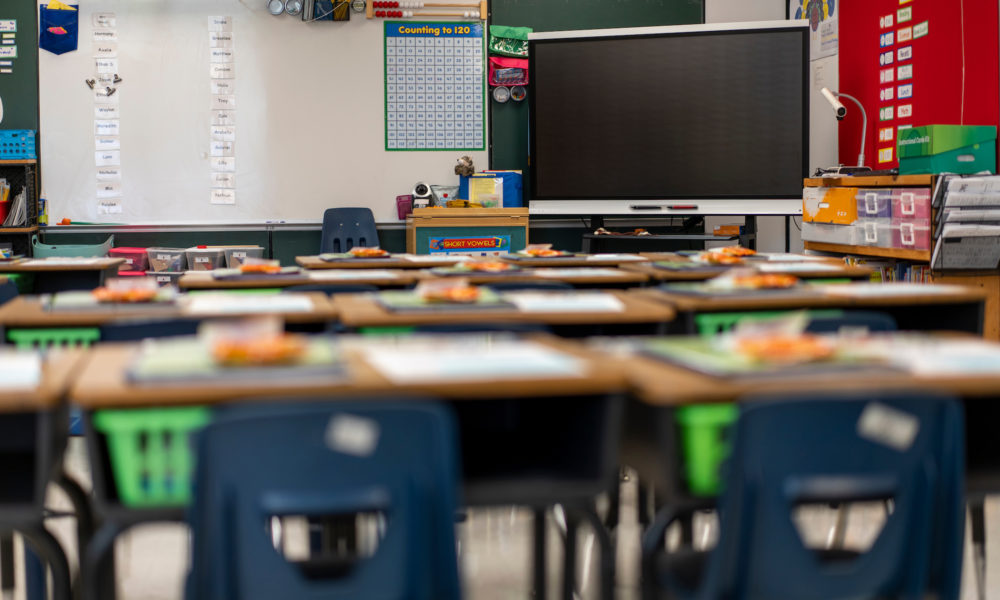Editor’s Note: This blog post is part of an ongoing series of posts dedicated to K-12 education policy in Mississippi.
***

By Grace Breazeale I K-12 Policy Associate
Mississippi experienced a steep decline in public school enrollment during the COVID-19 pandemic, and many schools have yet to experience the full consequences. Since enrollment is directly tied to school funding, a drop in students generally spells trouble for school budgets. The Federal Elementary and Secondary School Emergency Relief Fund (ESSER Fund) has filled in funding gaps over the last several years, but the expiration of this funding in September 2024 could leave some schools in perilous financial situations in the years that follow. Schools and local stakeholders—as well as the state at large—must be prepared for this financial fallout in order to mitigate its harm to students.
Falling Enrollment: Where Are The Students?
Mississippi’s public school system is no stranger to declining enrollment, which has been a continuous trend over the past decade. Even so, no one could have predicted the magnitude of the decline that took place between the 2019-2020 and 2020-2021 school years, when most school districts implemented some form of virtual learning in response to the pandemic. Despite hopes that enrollment would bounce back when schools transitioned back to in-person instruction, it continued to plunge.
Statewide Public School Enrollment

The total number of students enrolled in K-12 in Mississippi DECLINED BY 10% from 2011-2023.
Where did students go?
The decline in student enrollment can partially be attributed to demographic trends. Between 2010 and 2021, the number of residents in the 5-to-19 age group declined by 6.6% due to outmigration from the state and declining birth rates.
The loss of students in the public school system can also be explained by increased participation in alternative schooling options, such as homeschooling. Data from the US Census Bureau reveals an 11.6 percentage point increase in the proportion of homeschooled students in Mississippi between May and September 2020, over twice the percentage point increase nationwide.1
Relationship with Teacher Shortages
Teacher shortages have been a longstanding issue for the state’s public schools. Given that the number of teachers in a school is connected to the number of students, it is worth exploring the connection between teacher shortages and trends in student enrollment.
Between the 2018-2019 and 2021-2022 school years, the number of full-time teachers in the public school system decreased by 0.7%, while the number of enrolled students dropped by 6.3%. The graph below shows how these figures vary across school districts in Mississippi (note that each point on the graph represents a different school district).
District Change in Teachers and Students from 2018-2019 to 2021-2022
Most school districts lost students—many in the range of 5% to 15%. In contrast, about half of school districts gained teachers, while about half lost teachers.

*Graph based on similar figure by Chad Aldeman in The 74 Million
**Data Source: NCES
Why have teacher shortages persisted, despite the fact that declines in student enrollment have outweighed declines in the teacher workforce? In short, the supply and demand of licensed educators is more complex than a simple ratio of students to teachers in a given district. School districts may struggle to hire teachers in particular subject areas or particular schools within a district, even as the number of teachers in the district remains constant or increases. A district could have a high percentage of long-term substitutes or teachers on a provisional license; in the above figure, these individuals would still be counted as teachers in the districts.
Though not a perfect measure, the classification of critical shortage areas across the state captures some of the nuances of what it means for an area to have a teacher shortage. For a district to be classified as a critical shortage area, 15% of its teachers must not have a proper license (10% for districts with fewer than 60 teachers). Additionally, at least 30% of the district’s teacher workforce must have 25+ years of teaching experience. Despite gaining teachers and losing students, some school districts may be designated as geographical critical shortage areas because of high proportions of non-appropriately licensed teachers or older teachers. Given this definition, it is notable that the number of critical shortage areas in the state has more than doubled since the 2018-2019 school year, topping 100 districts for the first time in the current school year.
The relationship between student enrollment and the supply and demand of licensed educators is complex. In contrast, a loss in student enrollment has a clear implication: less school funding.
Financial Consequences of Declining Enrollment
As student enrollment declines, schools face significant financial challenges that may threaten the quality of education they provide for the students that remain.
Understanding Mississippi School Funding
The bulk of school funding comes from the Mississippi Adequate Education Program (MAEP), a statutory formula designed to ensure each district has the resources to provide an adequate education to its students. MAEP funding is distributed based on enrollment. In general, as enrollment falls, schools receive less funding. In rare cases, the state may pass a hold-harmless provision in which school districts may use enrollment prior to a decline to determine funding, but these only temporarily mitigate shortfalls.
MAEP is partially funded by the state and partially funded by local property taxes. The state has only met its funding obligations twice in the history of the funding formula, so schools are used to operating on a smaller amount. Even so, the size of the enrollment drop that occurred during the pandemic is unprecedented, and its impact on school finances has yet to be fully realized. For the past several years, districts have received large sums of federal ESSER funds, which they have been able to use to fill in some of the gaps caused by falling enrollment. ESSER funds expire in September 2024. Once these funds are no longer available, schools will face severe financial pressures that could force them to cut non-essential courses and extracurricular programs. Districts in the most precarious financial situations may have to close down schools or even consolidate.
The impact of decreased funding will be particularly acute for “property-poor” districts, due to the structure of the MAEP program. While “property-rich” districts—i.e., districts with higher property tax values—have the ability to provide substantial funds above what is mandated by the MAEP program, property-poor districts often, by definition, do not have these resources. In short, the consequences of decreasing enrollment on school funding are grave and may have long-lasting effects on the quality of education that Mississippi’s schools are able to provide—particularly for the students in the least-advantaged school districts.
Equity Implications of Declining Enrollment
Mississippi has a troubling history of enrollment trends driving inequitable funding in its public school system. When the Supreme Court ordered the state’s public schools to comply with integration orders in 1969, private “white flight” academies sprung up, effectively allowing segregation to continue. The private schools were majority white, while the public school system was majority Black. At this point, the state legislature began to lose an appetite for investment in the public school system, which has persisted. Even when the state legislature has managed to pass laws that appear to benefit schools, they have often failed to follow through with ongoing investment or proper implementation. MAEP, for example, was written to ensure more equitable funding for public school students—but has only been fully funded twice since 1997. Additionally, MAEP leaves room for more affluent areas to provide higher funding for their schools via property taxes.
At-A-Glance: Jackson Public Schools
Contemporary challenges facing Jackson Public Schools (JPS) exemplify a continuation of old patterns. In the past decade, the district has seen a sharp increase in students leaving to enroll in suburban public schools, private schools, and homeschooling—or even leaving the state entirely.
Jackson Public School Enrollment from 2003-2004 to 2022-2023.

The total number of students enrolled in K-12 in JPS DECLINED BY 40.9% from 2003-2023.
As enrollment has fallen in JPS, state funding has decreased, and the district has had to operate on a smaller budget. This has resulted in school closures and staff layoffs. Unless there is an unexpected increase in enrollment in the coming years, JPS will likely need to initiate more cuts in order to best serve students in the district.
Looking to the Future
As demographic trends and outmigration persist, student enrollment will likely continue to fall in many districts across the state.
1Data on private school enrollment during this time period is unavailable.

